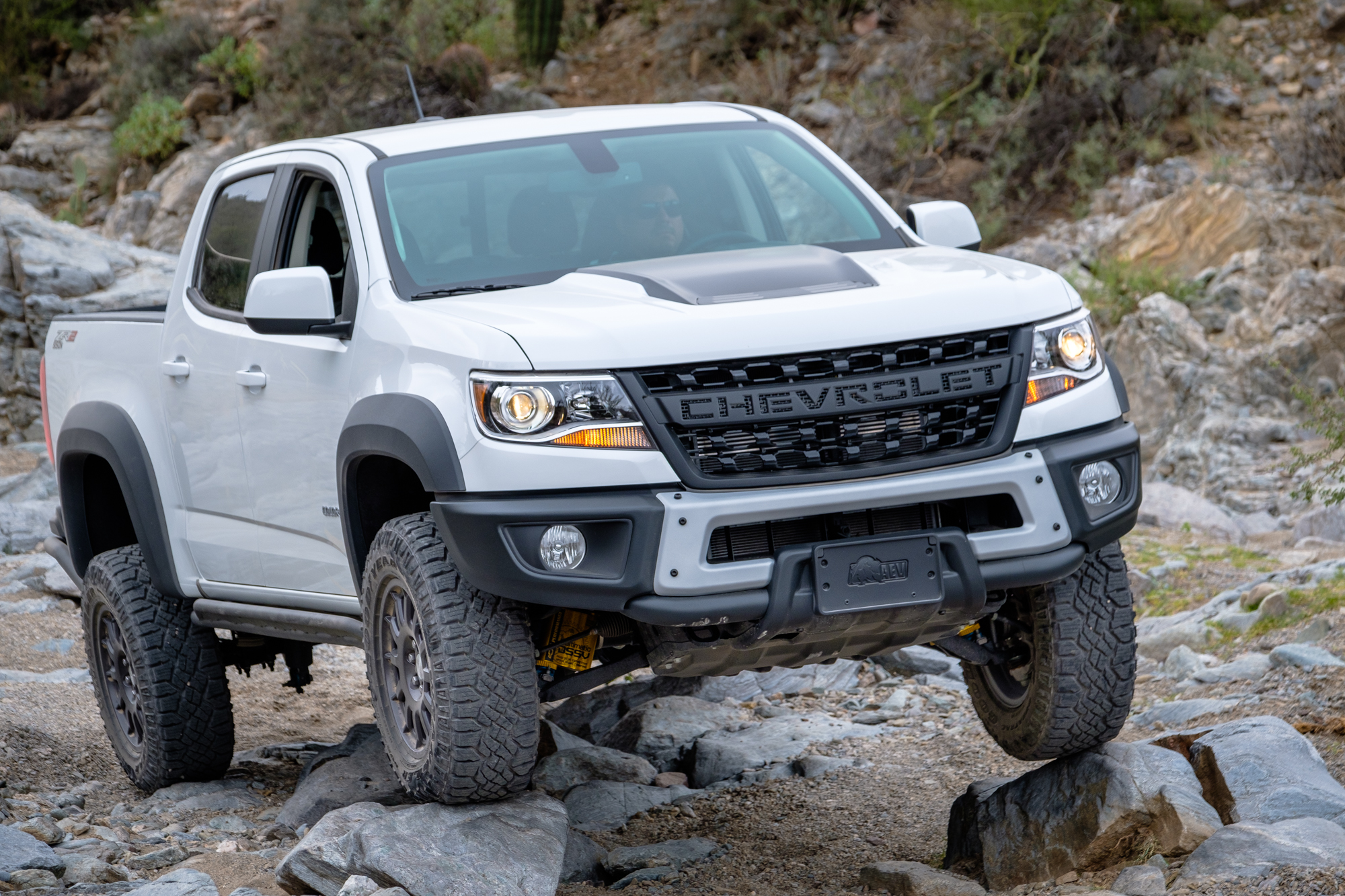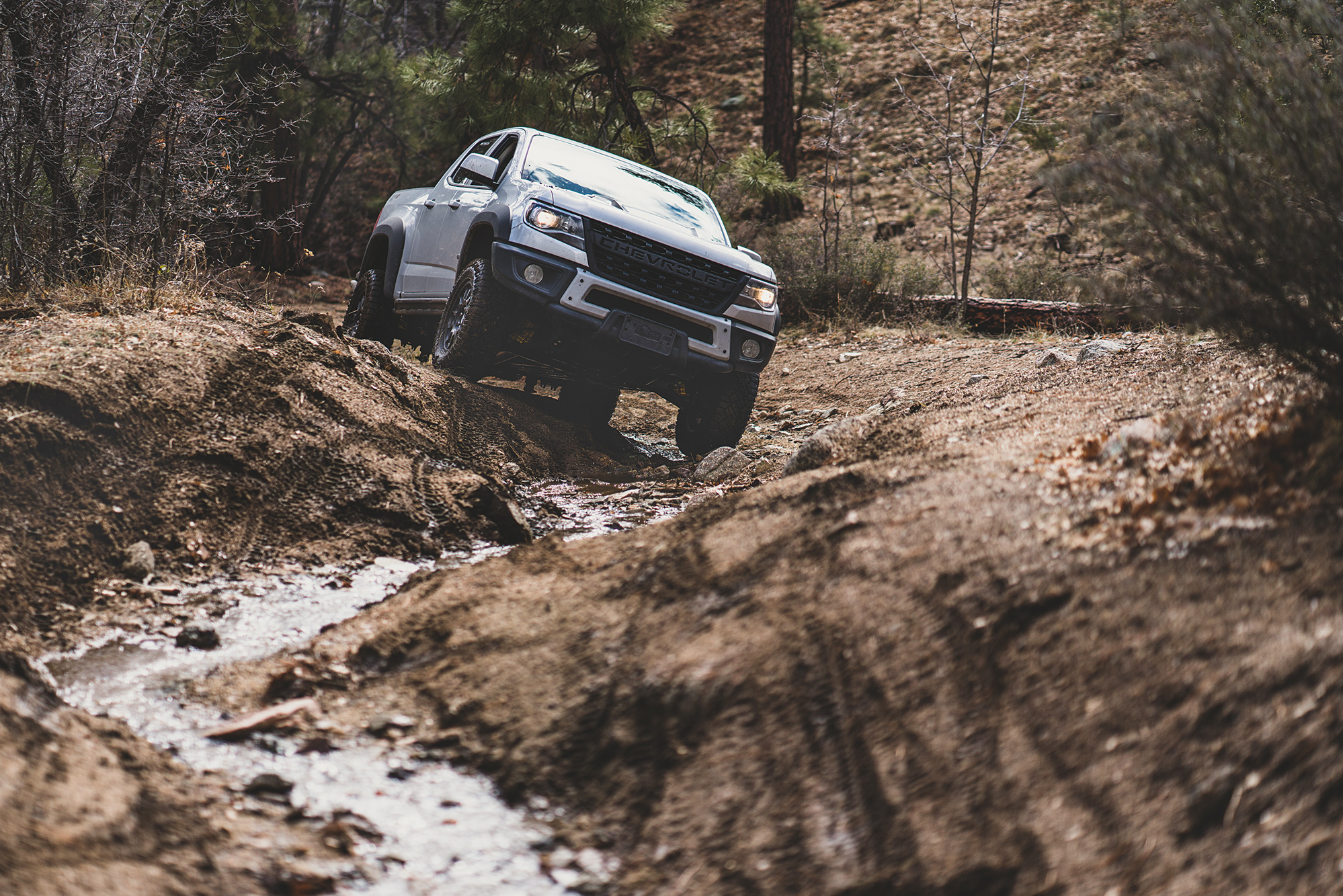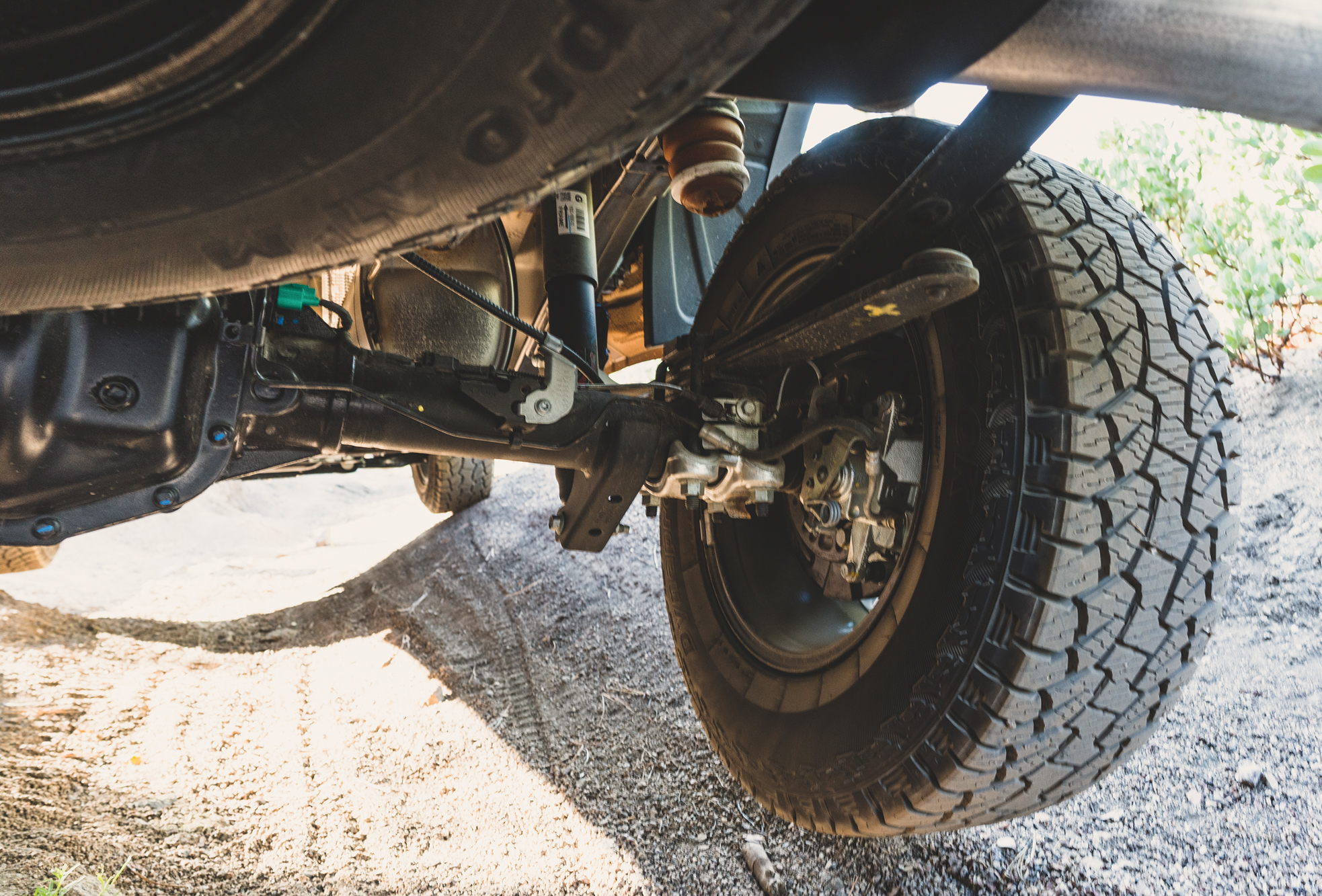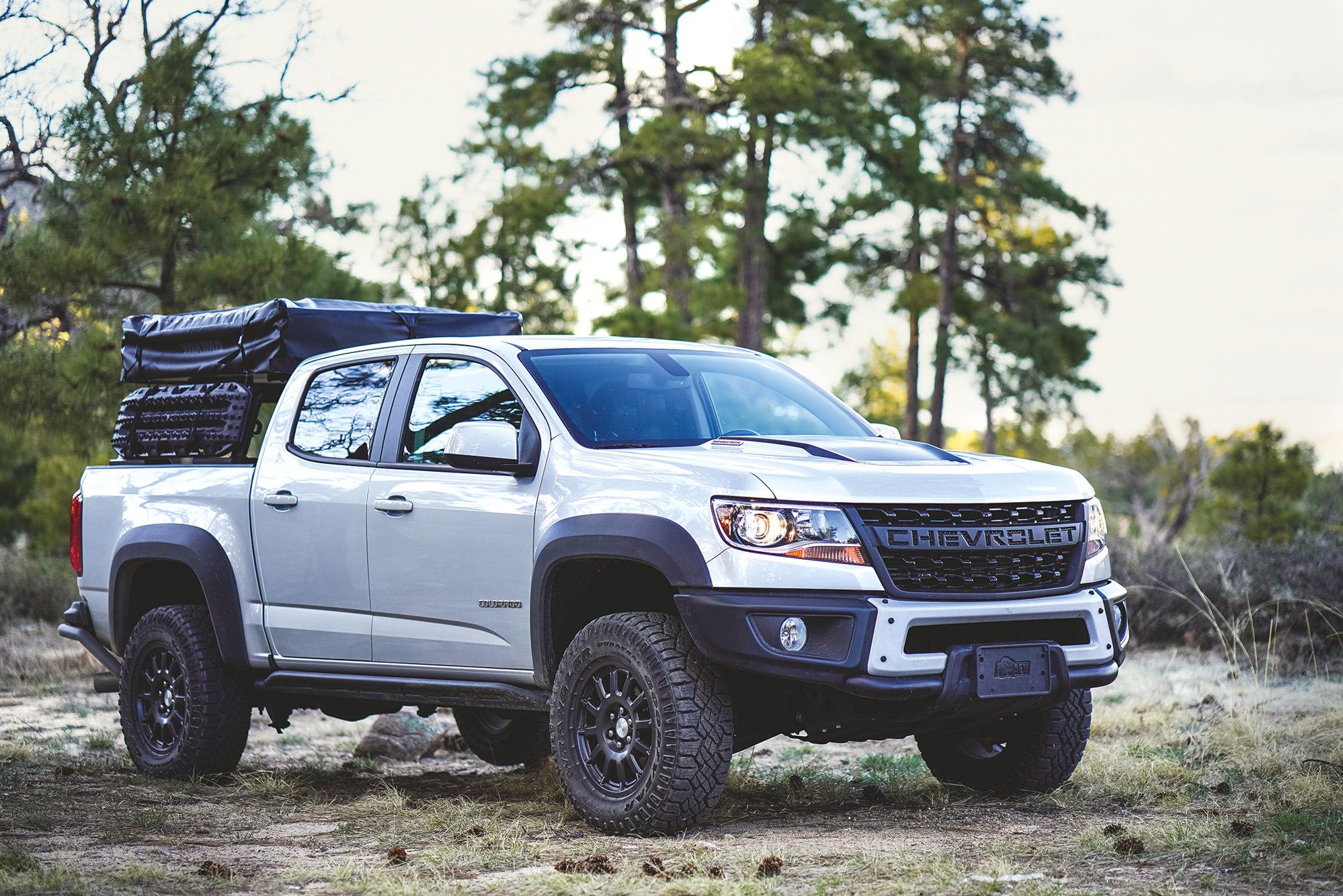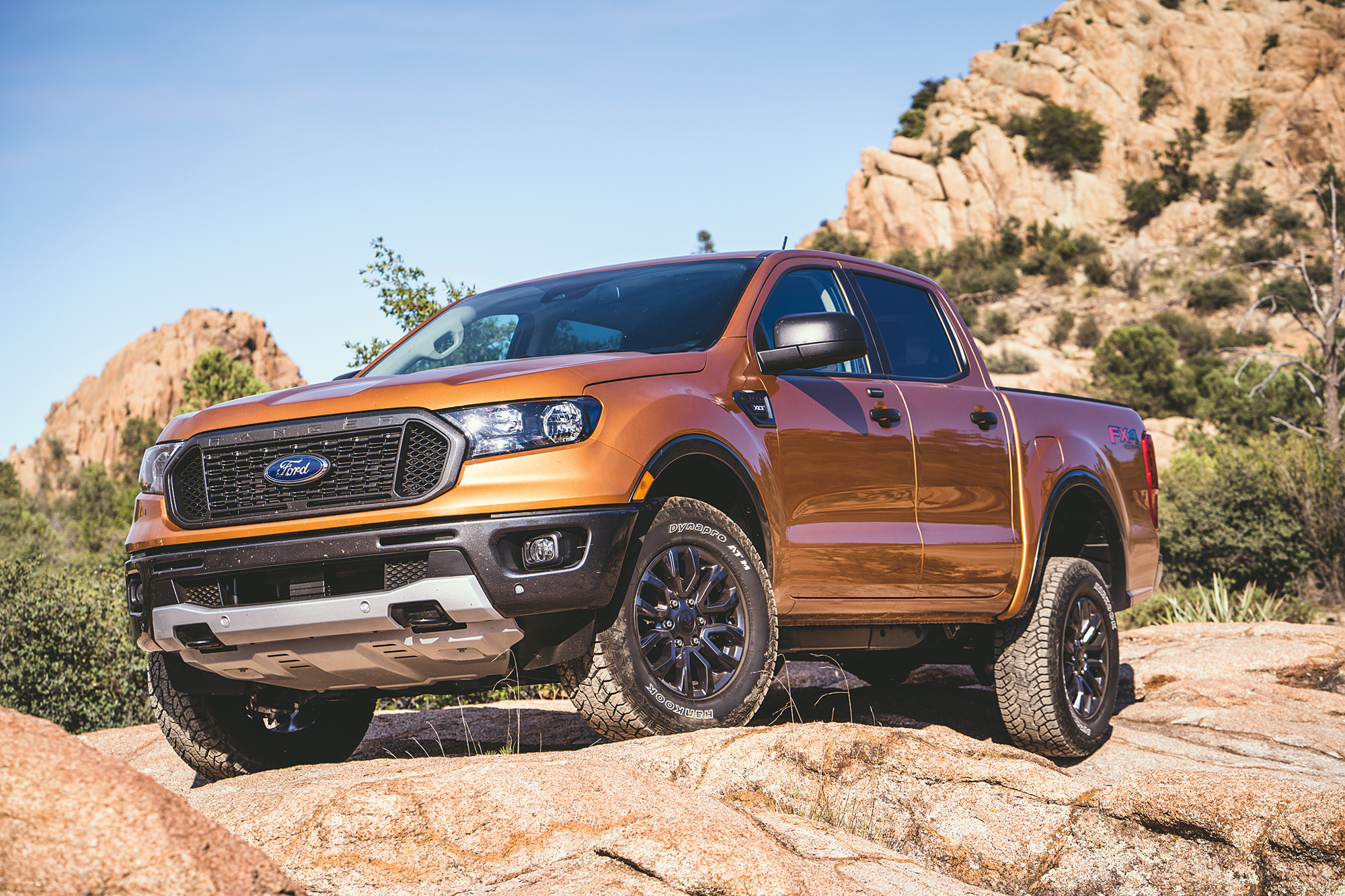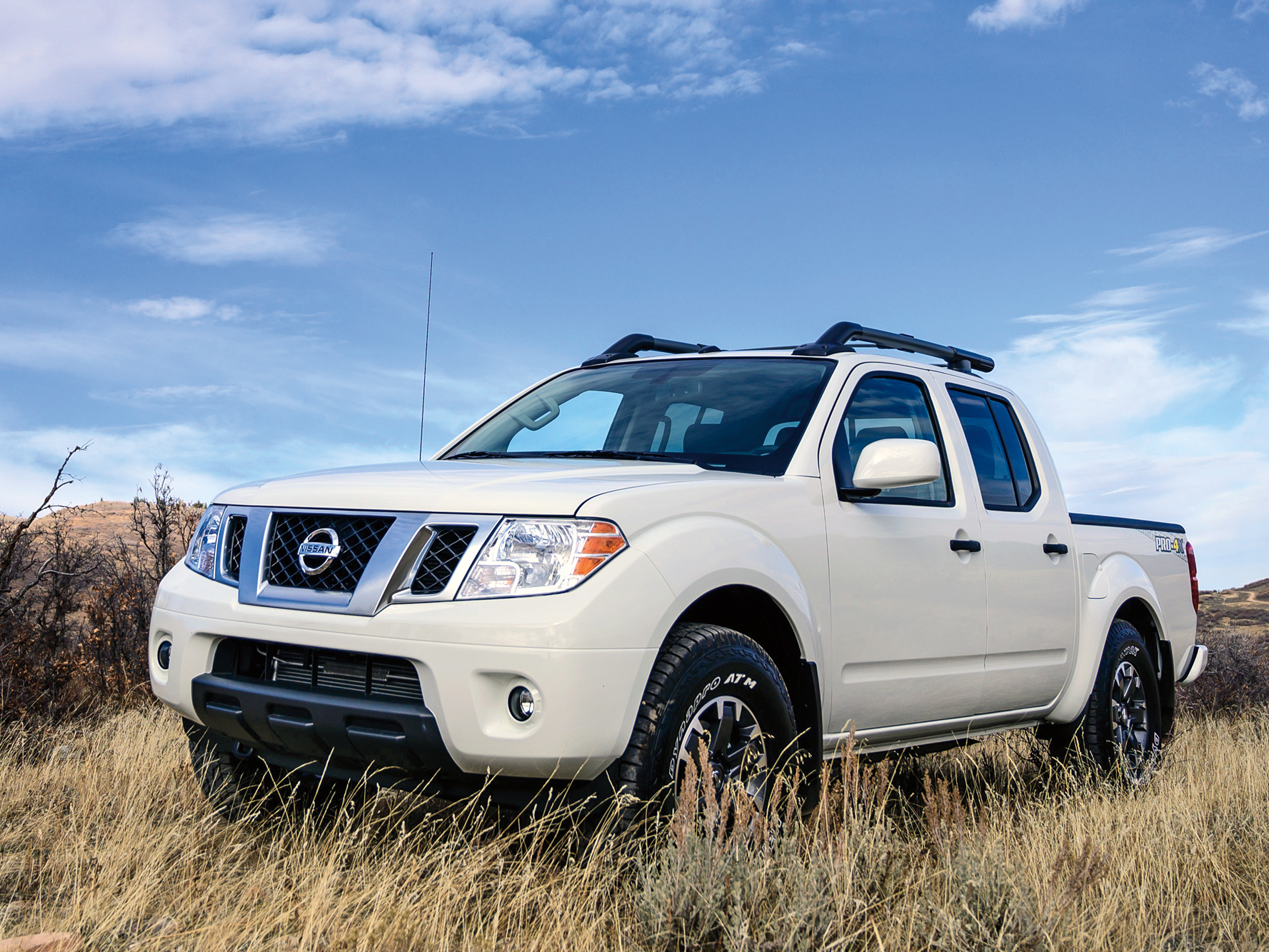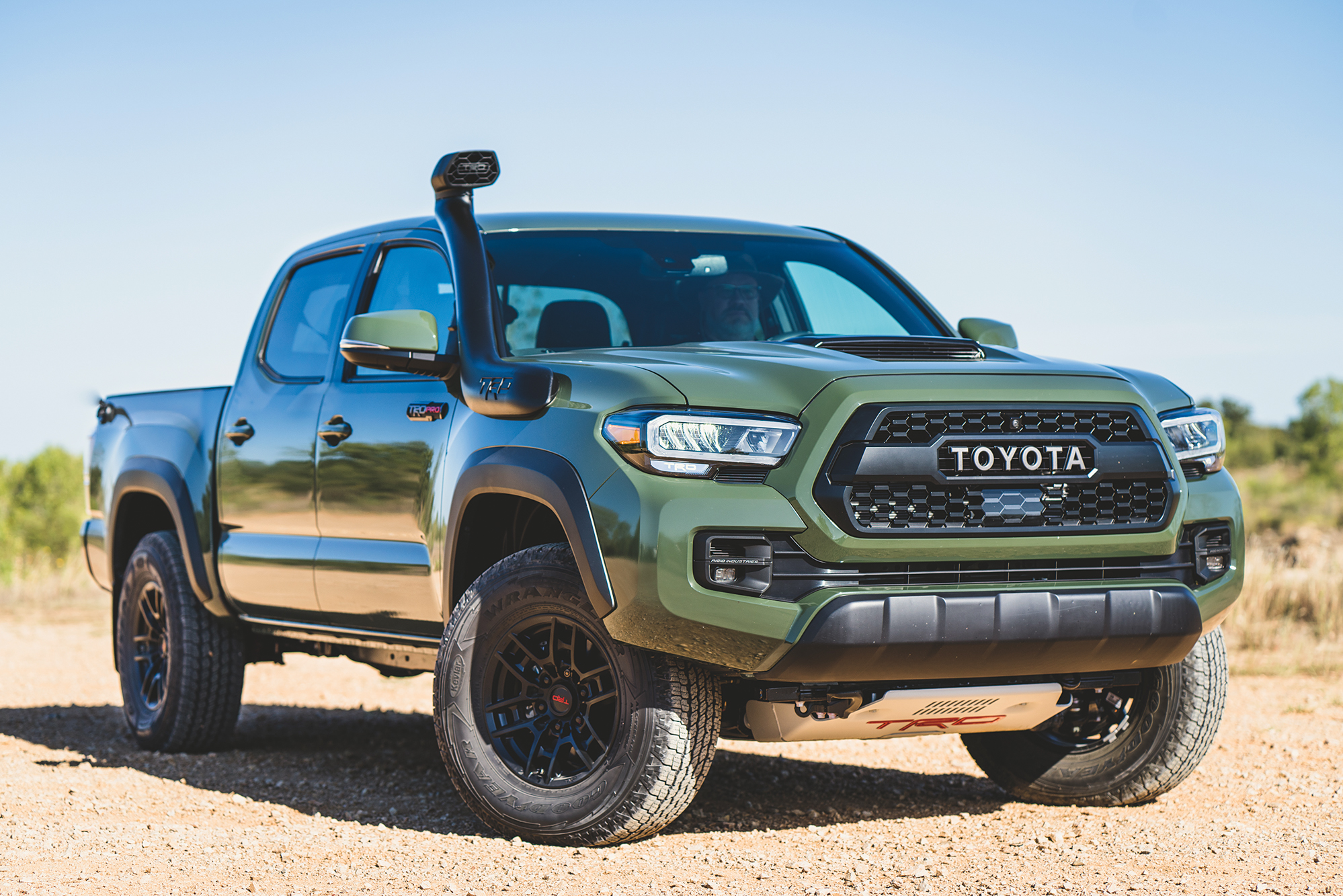Until a few years ago, there were only two suitable choices for a midsize overland pickup: the Nissan Frontier and Toyota Tacoma. That dearth of options resulted in limited innovation and notable apathy among both the OEMs and aftermarket. However, that all changed when Chevrolet, Ford, and finally, Jeep all released trucks into the market. As vehicle-based travelers, this is an exciting time with choices for the best midsize truck for overlanding that includes everything from diesel motors to solid axles to front and rear differential locks.
Overland Journal’s first project vehicle was a 2004 Toyota Tacoma, the revolutionary first-generation model that included a factory rear locking differential and the desirable TRD package. They sold in incredible volume and redefined the industry by besting all of the domestic offerings. In 2009, Toyota sold 111,000 units in North America, and the nearest suitable competitor was not even a third that number. To demonstrate the incredible growth of the segment, for 2018, the Tacoma was 245,000 units and the Colorado an impressive 134,000 units. Even the aging Frontier continued with strong sales at nearly 80,000 units. The crop of options is growing quickly, and now with the new Ranger and Gladiator, the market is more competitive than ever.
The growth of the segment and the general popularity of midsize trucks for overland travel-inspired our team to conduct this comprehensive review, logging thousands of evaluation miles and nearly 100 hours behind the wheel. This is our first Overland Truck of the Year test, which will be an ongoing series featuring all of the popular ranges, including full-size truck, SUV, and adventure motorcycles.
CONSIDERATIONS
The most significant advantage of purchasing a truck is payload, but that benefit begins to blur with the midsize options, as many offerings have marginal improvements in payload over established SUVs. For example, the 4Runner’s payload can range between 1,495 and 1,700 pounds, which is more than some units tested here. In that regard, it is important to consider a truck because we need a truck—for hauling motorcycles, home improvement duties, moving, and maybe even the occasional hayride. A truck can also afford more overall space for the payload than a wagon, and some people just enjoy owning and driving them because of their simplicity and utility. But most importantly, a truck allows for the installation of a true camper, like a Four Wheel unit, or a wedge-style camper. This is why payload remains critical in assessment.
For this evaluation and general considerations around purchasing a midsize truck, the following criteria (in the order listed) are the foundation for ranking vehicles in the segment.
RELIABILITY
For remote, vehicle-based adventure travel, we need to be able to trust our vehicle to start and operate reliably in the field. All of the capability and capacity in the world does little for us if the vehicle stops running. This attribute will be most important for those traveling the farthest afield and internationally, and it will be somewhat less critical for overlanders that tend to travel close to home with a dealer infrastructure in place.
PAYLOAD
One of the primary reasons to purchase a truck is payload, which allows for the reserve capacity to fit aftermarket accessories, campers, racks, and supplies. This may be as simple as weeks of fuel and water for a big desert crossing or travel deep in the jungle. Vehicles that are over GVWR can be subject to fines or even significant liability in an accident.
DURABILITY
Durability is a measure of long-term suitability to operation in abusive conditions: the construction of the frame, rating of the axles, amount and strength of the skid plating, and so forth. While a Subaru Outback is extremely reliable, it will not endure backcountry abuse in the same way a Land Cruiser 79-Series pickup will.
CAPABILITY
Overland travel can involve changing weather (snow and mud), washed-out roads, sand dunes, and rocky trails. Having reserve capability allows the driver to explore with confidence and reduce the chance of getting stuck or making it to that remote waterfall. Capability is a reflection of ground clearance, articulation, traction (i.e., lockers, advanced traction control), and even higher speed impact performance.
RANGE/ECONOMY
As travelers, we often explore remote locations or drive long distances between refueling. The fuel economy of the drivetrain and the size of the fuel tank both contribute to the available range. Fuel economy can also lower operating costs, which can allow for longer trips on a given budget.
RELIABILITY RANKING
For this test to have merit, both the evaluator and the reader must cast away as many biases as possible, particularly the belief that reliability rankings are a constant. It seems that any new offering is subject to the ad nauseum commentary of “Fix or repair daily” or “You better bring a mechanic along.” Reality proves to be different than those biases, with all manufacturers improving remarkably in this capacity for the past decade. For example, the overall winner in the 2019 J.D. Power Dependability Study for three-year reliability is the Porsche 911. Lexus remains the most reliable brand for 2019, but Toyota slipped to the third position behind Porsche, with Chevrolet in fourth, at only a 6-percent difference behind Toyota. Chevrolet is ranked higher as a brand than Nissan, Ford, and Jeep.
The story gets even more compelling when we look at the reported problems per 100 vehicles (PP100) within the first three years of ownership for the midsize truck segment. Per the 2019 J.D. Power Vehicle Dependability Study (VDS) rankings, the top three are #1 Nissan Frontier, #2 Chevrolet Colorado, #3 GMC Canyon. The Tacoma is now one of several very reliable offerings, as well as the Frontier and Colorado. I know, that statement is tantamount to heresy, and the pitchfork-wielding, khaki-clad mobs will be at my office door at any moment. Please don’t misunderstand, as I am a true believer in Toyota’s reliability, having explored much of the globe (and both Polar regions) with the marque. But for the sake of this evaluation, reliability will be weighted as it is reported; and at least when it comes to the Frontier, Colorado, and Tacoma, it is a dead heat.
TESTING
Over the course of nearly a year, we tested all of the new midsize truck models, including the Bison, Frontier, Gladiator, Ranger, and Tacoma. We also evaluated the Honda Ridgeline, which is a highly respected crossover pickup. Its lack of low range excluded it from the primary test, so we reported on it in the included sidebar. The testing involved driving each of the units through our test course, which includes highway, curving mountain roads, high-speed corrugated and rutted dirt, crossed-axle obstacles, steep climbs, and rock ledges. The test course provides a baseline of performance that was expanded upon during the individual overland trips. We crossed the Altar Desert with the Bison, drove to New Mexico in the Ranger, crossed the Mojave Desert with the Frontier, explored Sedona and the Mogollon Rim with the Gladiator, and took several Gen III Tacomas on trips in four states (we also own a Gen III Tacoma project vehicle).
Our evaluation reports include 28 off-highway and 24 on-road criteria that are reported from 1-5, with 1 being the worst result ever tested for any vehicle, and 5 being the best result ever tested for any vehicle. Because of this, the bulk of the outcomes are reflected from 1.5-4.5. Not all criteria are weighted equally, as payload is significantly more important than the comfort of the thigh bolster. While much of the testing is subjective, we have worked with Joe Bacal (professional driver and Toyota off-road evaluation engineer) for nearly a decade to refine our testing methodologies and repeatability. There are also objective measurements, such as ground clearance, MPG, and payload. All of these elements combined produce the results shared here.
CHEVROLET | COLORADO ZR2 (Bison Diesel Tested)
PAYLOAD 1,100 – 1,325 POUNDS | $52,845
PROS
Available diesel drivetrain
Class-leading dirt road performance
Ideal balance of capability, capacity, reliability, and durability
CONS
Interior lags behind the overall quality and appeal of the platform
Mismatched throttle/brake pedal heights
Bumper design of ZR2 (cooling) and spring rates downrate towing from 7,700 to 5,000 pounds
Chevrolet is one of the oldest brands in the test, started by Louis Chevrolet and GM founder William Durant in 1911. For over 100 years, Chevy has been one of the best-selling automotive brands in the world, with sales in 140 countries totaling over four million units. Chevrolet has always placed emphasis on truck production, and the Silverado is one of the most popular trucks in America. In recent years, their truck marketing and engineering teams have increased the emphasis on the off-highway performance of their trucks with the launch of the ZR2, then AT4, and most recently, the Colorado Bison. The quality of the Colorado has also reached notable levels, coming in second place behind Nissan for defects per 100 vehicles. The reliability advancements and now the Bison package with a diesel motor have literally vaulted the Colorado to the lead in the midsize overland truck market.
My initial tests of the Bison were so favorable that I decided to invite Joe Bacal to test the vehicle with me. Joe was a Toyota off-pavement vehicle test driver and multi-time winner of the Baja 500 and 1000. After a day of testing, Joe mirrored my results with the following summary: “effortless on the trail and confidence-inspiring at high speeds in the dirt.” The list of included features is precisely on target to an overland traveler, and GM even proclaimed the Bison as their first “overland offering.” Most important is the available diesel motor, a 2.8-liter Duramax that produces 369 pound-feet of torque and returns an average economy (in our testing) of 22 mpg, which includes a mix of highway, city, and trail driving. Longer highway trips yielded results as high as 30 mpg. The front bumper is designed and built by AEV and has a provision for a winch tray. The rear bumper is also steel with integrated tubular quarter panel protection. From there, it just gets better with boron steel skid plates, front and rear locking differentials, and the Multimatic Dynamic Suspension. The effectiveness of Multimatic dampers cannot be overstated and results in the best performing vehicle in the class at all speeds.
What makes the Colorado Bison perform so notably is the sum of its parts. While our summary of the Bison appears glowing, how many of us could have imagined even five years ago that a midsize truck could be purchased with a diesel motor, front and rear lockers, factory winch bumper, rock sliders, and boron steel skid plates? This is not to say that the vehicle does not have a few minor deficiencies, like the very pedestrian interior, and mismatched throttle/ brake pedal heights, but other than that, we would just be nitpicking. Of course, all of this high-performance hardware and a diesel drive train comes at a cost, the package pushing well above $50,000. But for that investment, you can buy one of the most exceptional overland trucks ever sold in North America.
FORD | RANGER XLT FX4
PAYLOAD 1,560 – 1,650 POUNDS | $35,625
PROS
The EcoBoost engine is magic
High-quality interior with low NVH
Up to 1,650-pound payload
CONS
Limited articulation
Heavy step-out on corrugated surfaces
Firm shock valving creates a busy ride on the road and off
Ford was founded in 1903 and is the second-largest domestic automaker behind GM. As a company, they have led truck sales for decades, and have invested heavily in recent years across their entire truck line, from the wildly successful Raptor to the Ranger we tested here. Part of that investment is a shift toward high output: high fuel economy engines paired with up to 10-speed transmissions. In the case of the Ranger, the 2.3-liter 4-cylinder engine produces an astonishing 270 horsepower and 310 pound-feet of torque, more than 14 times the output of Henry Ford’s first Model TT pickup.
From the moment I started driving the Ranger, it was clear that it is unlike any other midsized truck on the market. The ride on the road is extremely composed, and there is not a rattle, shake, squeak, or wind whistle anywhere—it feels like a vault. When I first heard that the new Ranger would be fitted with a 4-cylinder engine, I was underwhelmed. But all that melted away under smoking tires once I drove it. If this is the future of gas engine technology, sign me up. The torque is prodigious once the turbo starts to spool, and it literally brought a smile to my face as it ticked off a sub-seven-second 0-60 run. The overall configuration of the interior is also quite good, with a bigger door opening and comfortable seats. Driver fatigue was low, and I hardly noticed a 1,000-mile drive to Taos and back. The rear seating area is the smallest in the test.
On the trail, the FX4 package provides the hardware needed to negotiate technical terrain. The rear locker engages easily with the push of a small button near the shifter. The terrain management settings configure the throttle/transmission/traction control mapping for the desired terrain. This feature is most beneficial in sand and mud, reducing TC intervention and allowing necessary wheelspin. The trail control system is one of the smoothest in the test, but traction control (TC) intervention is slow. I also liked that the rear locker could be engaged in 2WD and that there is a real hand brake. In slow-speed technical terrain, the Ranger performs well but needs improvement in articulation and TC effectiveness. I also noted that the TC disables under left-foot braking— not good. The lack of articulation and too-heavy rebound in the dampers results in quite a bit of head toss and a tendency for the truck to unload suddenly (pop) when a tire starts to leave the ground.
At higher speeds on the dirt, the Ranger is quiet and rattle-free. The stability control shuts (mostly) off when the button is pressed, and the tires have good grip. However, the suspension is very tied down and slow to respond due to the shock damping, which causes the truck to suffer from heavy step-out on corrugations. Overall, the Ranger is both an excellent value and a blast to drive both on the road and off.
JEEP | GLADIATOR SPORT MAX TOW PACKAGE
PAYLOAD 1,700 POUNDS | $39,230
PROS
Best-in-class payload
Best-in-class towing
Extremely robust throughout
Available 6-speed manual transmission
CONS
Max tow package and 1,700-pound payload not available on Rubicon
Lacks steering directness and precision at higher speeds
Overall size limits some technical terrain performance
The Jeep Gladiator has been the most highly anticipated launch into the overland market in decades, and for good reason. The new model incorporates the technical terrain attributes of the Wrangler and adds the payload and carrying capacity of a truck. This melding of the two ideas has resulted in an overwhelming sales success. From the perspective of overlanding, the Gladiator also addresses one of our primary concerns with the Wrangler— payload. A Wrangler has 1,050 pounds of payload, less than most passenger cars, but the Gladiator adds over 600 pounds to that number, which makes all the difference when an overlander needs to outfit a vehicle for remote travel.
Even 10 years ago, few remote, long-distance travel vehicles were Jeeps. It is not that it couldn’t be done, as Dan Grec drove around South America in a soft-top TJ, but most buyers wanted the payload and cargo volume of a larger vehicle. The Wrangler TJ Unlimited was the start of the shift, followed by the JK Unlimited. Now, the Gladiator has a 1,700-pound payload capacity (60 percent increase over the Wrangler), along with a notable increase in cargo area. The Gladiator is also fun to drive with a responsive 285 horsepower V6 and 8-speed automatic; a 6-speed manual transmission is also available. Even with the vehicle’s size, I achieved an impressive 21 mpg in mixed driving.
On the trail, the Gladiator Sport was highly competent, although the lack of locking differentials was noticed, the traction control intervening regularly. However, the TC works well and does not defeat under left-foot braking. This brings up the reason why we did not specify the Rubicon for this test. Unfortunately, all of that off-pavement hardware reduces the payload by 500 pounds, which is more than the weight of a shell model Four Wheel Camper. We wanted to evaluate the most overland-appropriate model, and the Sport Max Tow Package unit has the best payload and tow ratings. Personally, I would prefer the additional capacity, as adding a rear locker costs far less than the Rubicon package.
For most dirt driving, the Gladiator is really impressive given the wheelbase. Even the stock suspension does a good job of managing larger impacts. Head toss is okay, and the vehicle remains composed, rarely unloading unpredictably, and generally providing excellent articulation despite the front sway bar. We did some testing with the front sway bar disconnected, and while we can’t recommend it, all of the performance (even high speed) got even better. Highspeed dirt performance was also notable, with limited step-out and excellent predictability. It is worth noting that the Gladiator has the highest payload in the test, and the best articulation, all with a coil-sprung rear suspension. In my experience, the Gladiator is all I love about the Wrangler, plus nearly all I love about a Power Wagon. In addition, the Gladiator is the aftermarket darling, so anything imaginable can be bolted to it, although it needs almost nothing at all.
NISSAN | FRONTIER PRO-4X
PAYLOAD 1,040 – 1,180 POUNDS | $33,530
PROS
Class-leading reliability
Available 6-speed manual
Dana 44 rear axle
CONS
Poor braking effectiveness and heat management
Needs three more transmission gears
1,040 – 1,180 pound payload
Nissan is one of those brands that is so honest and reliable that you rarely hear a cross word said about their vehicles. They have somehow risen above the petty brand rivalries and produced one of the most durable, capable, and best-value midsize trucks on the market. Nissan makes the legendary Patrol, and its DNA is evident throughout the Frontier. Most notable is that the Frontier is the most reliable truck sold in North America, both for initial quality and for 36-month dependability (J.D. Power). The Nissan also proves to be an impressive value, with the base model 4WD truck available for as little as $28,600 before incentives or dealer discounts.
The Frontier is both comfortable and competent on the trail and feels well-suited to the task. Between the large tire diameter of the Pro-4X and 10.1 inches of ground clearance, it easily completed our test loop. The locking differential is key to this performance, as the traction control is only marginally effective and cancels under left-foot braking. Front articulation is limited due to the sway bar diameter, but rear-wheel travel is generous. Overall stability and compliance are average, with moderate head toss and a tendency for weight transfer to shift quickly (pop) in cross-axle terrain. Control in technical terrain is reduced due to the tall overall crawl ratio of 33:1. It was particularly noticeable when crossing a downed log, requiring much deeper throttle application and heavy left-foot braking to maintain precise control. This complicates matters, as traction control deactivates (for the front axle in this case) with left-foot braking. In general, the competition has much lower crawl ratios.
On the road, the Frontier felt familiar and even fun to drive. I appreciated the strong output of the large displacement V6 (the biggest in the test) but wanted more transmission gears. It would be tempting to describe the interior as basic, but I actually appreciated that. It didn’t feel fragile, but commercial and intentionally durable. My biggest concern on the highway was the braking performance, fading in particular. During my mountain road loop test, the brakes were exhibiting a soft pedal and notable fading within just a few minutes of higher speed evaluations.
The Frontier is not the most technologically advanced vehicle in the test, but that reflects the age of the platform. As with anything, maturity has its advantages, and in the case of the Nissan, that results in exceptional reliability and value. The vehicle also feels straightforward and capable in Pro-4X trim, even down to the 16-inch wheels, 265/75R16 tires, and fully boxed steel frame. Even the axle is a tried and true Dana 44. With the limited payload of 1,040 to 1,180 pounds, owners will need to keep modifications limited, and equipment minimalistic, but just the cost savings alone over some of the other models will pay for a trip from Alaska to Panama—and back.
TOYOTA | TACOMA TRD PRO
PAYLOAD 1,135 – 1,155 POUNDS | $46,665
PROS
Properly tuned Fox shocks
Tacoma dependability
Genuine off-pavement hardware
Available factory-raised air intake
CONS
Transmission ratios not matched to truck use
Lowest payload in the test at 1,155 pounds
The Tacoma has been the benchmark of compact overland trucks since its introduction, and the model represents 62 percent of all trucks reported in our reader surveys. Overland Journal has owned a Gen 1 and Gen 3, and we have driven Tacomas from the Arctic Ocean to the Darién Gap in Panama. The history of the Toyota compact truck in North America goes back to the launch of the Stout, which gave way to the HiLux. In 2005, the Tacoma began production in the United States. The changes made to the frame and spring rates resulted in better ride quality, but a lower payload (the payload for US-spec, compact Toyota pickups was as high as 2,655 pounds). Despite these changes in capacity, Toyota’s famous reliability remained, and the Tacoma has become the best-selling midsize truck in America.
On the road, the Tacoma is a comfortable and efficient cruiser, returning good MPG while unloaded. The seat is lower than my liking, and the ceiling is also quite low, requiring a bit of contorting to get into the driver’s seat. But once inside, it is a comfy place with supportive seats and easy-to-read analog gauges. Most of the off-pavement switches and dials are located on the ceiling, including rear locker, terrain select, and crawl control. All of these systems work extremely well, clearly designed by engineers that actually go off pavement. The same is true for the internal bypass 2.5-inch Fox shocks, which have been significantly retuned for 2020. This change in valving has contributed to better compliance and control at both low and moderate speeds. I noted a drop in head toss, and that the truck better utilized the entire suspension travel. The previous tune was too stiff, but this one is just right. I also noted an improvement in the spring rates, resulting in better frequency tuning and less step-out on corrugations.
In technical terrain, the rear suspension exhibits good articulation, and the improvement in valving minimizes sudden unloading or dynamic weight shifting. The front skid plate is an aluminum unit (1/4 inch thick) and runs to the oil pan. The TRD Pro also includes a new exhaust, Rigid fog lamps, and redesigned bumper fascia for an improved approach angle. I appreciated the 16-inch wheels. Also of note is the factory-raised air intake, which is unique in the segment.
My criticisms of the vehicle sit squarely with the payload capacity and the transmission. As a point of reference, Toyota makes passenger cars with higher payload ratings than the Tacoma. Its 1,155 – 1,285 pound rating makes it difficult to install anything beyond a basic camper. Once a bumper, winch, additional fuel, tools, food, water, and occupants are considered, there is not enough capacity. In all candor, the automatic transmission is a disappointment. The first few gears of the transmission are too tall. For example, the Gladiator has 28 percent lower overall gearing when starting in first gear. This gearing mismatch results in lackluster performance when unloaded, and unsettling responsiveness once a camper or trailer is added. Other than these few concerns, the Tacoma is an exceptional vehicle, and one deserving of the Toyota legacy.
Honorable Mention
HONDA RIDGELINE
PAYLOAD 1,451 POUNDS | $35,290
The models showcased in this test are not the only midsize trucks in North America. The Ridgeline is highly respected for its overall reliability, safety, and road performance. It was only excluded from the main test due to a lack of low range, but we did secure a unit for evaluation. Some travelers do not need or desire low range and would prefer to gain the handling, efficiency, and reduced cost of an AWD. The Ridgeline comes equipped with a 280-horsepower V6 that achieved an average fuel economy of 20 mpg in our testing, and 26 mpg on a long drive to California.
Off the highway, the Ridgeline did surprise me in a positive way, but it does have limits. It completed nearly all of our test loop, although with tire-lifting (and spinning) flair. The traction control is multi-mode, but on the dry dirt of our track, it worked best in auto mode. While the lack of low range is understandable, it needs a center differential lock button for any prolonged use on the trail; this would reduce tire spin and heat generated within the AWD system and transmission. The payload of 1,451 pounds is commendable, and it is fun to drive on any curve-filled surface.
CONCLUSIONS
This is our first Overland Truck of the Year test, and coming to a conclusion required significant validation and deliberation— picking the winners for both the Editor’s Choice and Value Award was a challenge. It was important to control as many biases as possible, and to also look at the attributes as a brand agnostic. While there is considerable objective evaluation in this test, it is balanced with the evaluators’ notes and independent third-party accolades. As overlanders, we require a reliable and capable vehicle with enough capacity to support travel to remote destinations.
There are a few reasons why we harp on payload so much, but it comes down to liability and safety. It has somehow become avantgarde to modify and load a 4WD into obesity, but how can that vehicle stop properly, or avoid a child in the road with an emergency lane change? And if you are in an accident, most insurance companies have clauses that allow denial of a claim if the vehicle is over GVWR. That is not to say that a lower payload is not suitable for overland travel, but the buyer’s intention with the project needs to match the GVWR.
VALUE AWARD
What truck in this test represents the greatest overall value, the vehicle most likely to have the lowest overall cost of ownership? For this evaluation, the value leaders are the Nissan Frontier ($33,530) and the Ford Ranger ($35,625). And if the buyer is willing to be minimalist, the Ranger can be purchased with a rear locker for just under $30,000, and the Nissan as a base model 4WD for $28,600. In my view, these are both exceptional values, but both have different strengths to bring to the table. The Ranger gives a full range of modern technology for 35 grand, while the Frontier gives proven durability, reliability, and capability. The Frontier is also $20,000 less expensive than the Bison, which will pay for a lot of travel. As an overlander, reliability remains one of the most critical attributes of any vehicle we purchase, so the Nissan wins our Value Award and will give decades of service to the buyer.
EDITOR’S CHOICE
The Editor’s Choice Award is given to the product or vehicle that the editor would purchase, despite the price. I have always owned and trusted Toyotas, but truth be told, the Bison, Gladiator, and even the Ranger are better overall than the Tacoma. I suspect this is primarily due to timing and Toyota’s conservative nature. I also suspect all of these other manufacturers knew the benchmark they needed to beat. And while the Ranger was an absolute joy to drive on the highway, it lacked the execution of purpose that the Bison and Gladiator have. This left the Editor’s Choice between those two.
The Gladiator Sport Max Tow model is without question the most truck-like of the test; even the frame engineering was done by Ram, and everything about it reinforces capacity. It is stable and competent under both towing and hauling loads. I also appreciate the solid axles and coil-sprung suspension, but one cannot ignore that the Max Tow package is not available on the Rubicon. The Sport hits our expectations for payload and towing, but struggled against the Bison in all dirt environments, lacking lockers and trail protection. The Bison was effortless, while the Gladiator required constant spotting to avoid the soft bits. It was also the only vehicle that could not clear our breakover challenge. Yet the Gladiator is ready for real overland loads, and it will bring a giant smile every time you look at it—we finally got a Wrangler truck.
Our 2019 Overland Truck of the Year (midsize) goes to the Bison. Just a list of its features makes it the “HiLux” we always wanted, only better. It is available with a small-displacement turbo- diesel, front and rear locking differentials, a winch-ready steel front bumper, steel rear bumper with 1/4 panel protection, fulllength rock sliders, class-leading suspension, and scores second on J.D. Power’s reliability ranking (behind the Frontier). It checks all the boxes. Joe Bacal, our resident vehicle dynamics evaluator, said of the Bison, “It is my job to pick this truck apart, but I am struggling. It hit all of the marks.”
The Bison even has a respectable payload (nearly 1,500 pounds for some configurations), particularly once you factor the 200+ pounds of bumpers, sliders, and skid plates that are already installed from the factory. The only real curiosity with the Bison is the 2,700-pound tow rating reduction from the standard Colorado. That appears (from a source that requested anonymity) to be related to the reduced airflow the off-pavement bumper.
The Bison is exceptional on the dirt at any speed, and I believe it would even hold its own against a stock Gladiator Rubicon in all but the most obscure recreational rock-crawling scenarios. It is easy to be obsessed about that additional 1 percent of performance advantage, but the Bison has all of the capability I expect from an overland truck, and greatly exceeded my expectations for performance on dirt trails and roads. The Bison is the overland truck we have all dreamed about, and it is available in North America.

Critical Editorial Note: (Updated 3 Feb, 2020)
At the time we tested the ZR2 Bison (late 2018 and again in early 2019), the payload data for the model was provided as 1,495. Since that time, detailed payload information has been made available for all iterations of the ZR2. Additionally, we confirmed finalized numbers and have spoken with GM engineering staff.
Highest Payload Configuration: 1,325 pounds for V6, Access Cab ZR2
Lowest Payload Configuration: 1,100 for ZR2 Bison, Crew Cab Diesel
We have also adjust the scoring for the ZR2 from the original printed article to reflect this. Testing results now reflect 3.5 to 2.75 for capacity, and the overall score from 18.5 to 17.75.
The consumer should consider that both the ZR2 and in particular the Bison package includes accessories that are typically installed in the aftermarket. This should be factored when comparing apples/apples with the payload of other models in this test.


